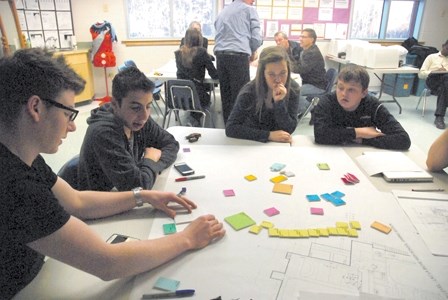As part of the design process for the new high school that is to be built and attached to the Bold Center in the next year, architects from Stantec visited students at J.A. Williams High School in Lac La Biche to get their perspective on what would make the best design and layout.
“We did a similar session with students, parents, and staff at a school in Grand Prairie. We found it very interesting because the students had entirely different perspectives and takes on everything from the main entrance to the gym,” said Bill Saul, project coordinator and a Senior Associate at Stantec.
“This is great because we get all kinds of ideas and everyone can contribute equally,” he said.
The session was a two-day affair that invited high school students from JAWS but also future students who would be attending the new school from Dr. Swift Middle School. In addition to the students who participated, the session also invited parents and staff to take part in the developmental process.
“I think because we are the ones that hear our kids comments and complaints about life in school, we get to hear certain opinions that can’t always be expressed in the [current] school environment. I think this is why we as parents bring in a slightly different opinion,” said Julie Benson, JAWS parent council president.
The session started out on Dec. 6, with an informative lesson about 21st century learning and Leadership in Energy and Environmental Design (LEED) which consists of rating systems for the design, construction and operation of high performance green and environmentally-friendly buildings.
“Teaching environments, training and learning are more interactive now than ever before,” Saul said. “In order to accommodate that change in the learning process we need to create breakout spaces and have students’ collaboration. We are trying to create the ideal teaching environment. This is a democratic process to promote ideas.”
By Day 2, the students and attendees got down to business and broke into three small groups, each ready to roll on the layout process with a set of movable foam pieces labeled to the needs of the school. Each group contained parents, students, school staff and a member from the Stantec team to help with the process.
“The process by design, in my opinion, is the best way to get student input outside of surveys and it is more hands-on,” said JAWS principal Terry Moghrabi.
In fact, this design process is something that Saul thinks is very important and often tries to coordinate when working on projects that greatly affect so many people, especially students.
“I believe [students] should be involved and their opinions are highly valuable,” Saul said. “Students come in and have fresh ideas because they haven’t yet been encumbered by adult views of the world. They bring in playful insights.
The students also seemed to find the process of being involved informative and exciting.
“It’s cool because we get to go there and graduate from a school we helped to design. We get to see some of our ideas [put into action] in the future” said Grade 8 student Jayden Draney.
“We get to be part of something and put our perspective on something that people will be in afterwards,” added middle school classmate Maddie Stevens.
Similarly, the high school students felt that the experience was just as necessary and well needed.
“I think it’s really good getting students’ input because it affects us the most,” noted Grade 9 student Nicole Funk. “There are lots of learning opportunities. I’m excited to be working on such a good opportunity [to learn].”
Even the older high schools students who may not get a chance to take advantage of the school before it’s completed thought the process was a good experience.
“I think it’s good and we get to view the process, especially if you might like to pursue architecture as a career. It’s as new opportunity to take advantage of,” said Grade 11 student Bryce Tkachuk.
By the end of the second half-day session, Stantec representatives had three possible layouts and design elements that could accommodate all the wants and needs of those who would be using the school the most in the future.
“There is tremendous opportunity to bring in different opinions and it’s a give-and-take process so the students can learn what can be sacrificed here and there in order to thrive,” noted Moghrabi.
Assuming the plan and process as laid out by Alberta Infrustructure continues on schedule, the new school is set to break ground in late Spring 2012.



